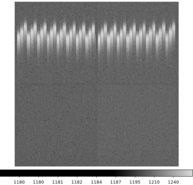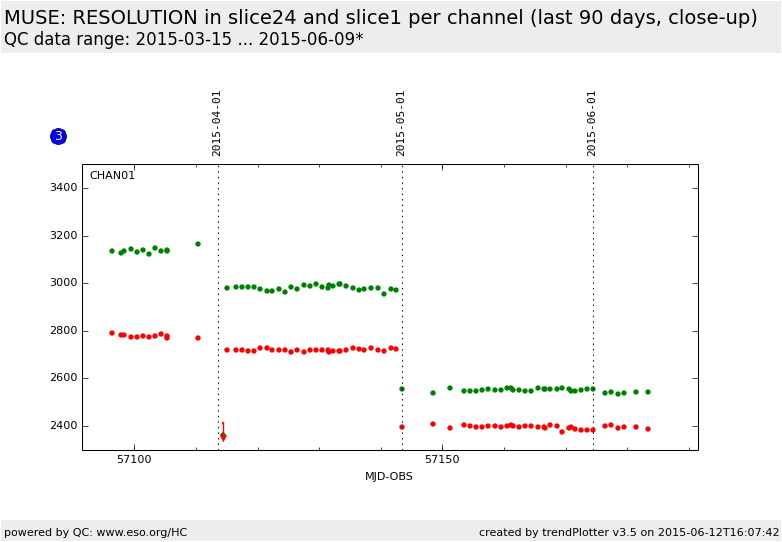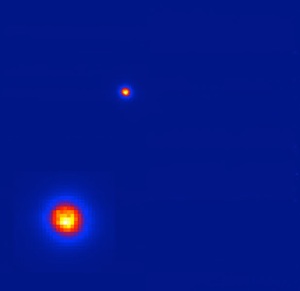MUSE News
On this page, we list the main changes that affected MUSE and this web site.
Timeline of instrument status
The following table describes the events affecting the quality or the measurement of data obtained with MUSE. Its content can be downloaded as a Comma Separated Values file. It is complete as of November 6th, 2020.
The Start Date column indicates when the event took place. Some events cannot be defined by a single instant, but extend over sometimes several days, weeks or months. Operation with the instrument may continue while the event occurs, in which case the Ongoing flag is set. If the event had ended, the Ongoing ? flag is lowered and End Date is given. The Type column indicates the characteristic(s) of the event: Earthquake, Maintenance, Upgrade, Element failure, Intervention, Pipeline installation at QC, Change of nominal values or thresholds, Modification of configuration file of this database, or Other. The Instrument Modes column indicates the affected mode. The column KPI indicates which quality control parameters identified as Key Performance Indicators (i.e., parameters following the most critical quantities) are affected; the column non-KPI indicates which other critical Quality Control parameters are affected. The Calibration Raw Types column indicates the raw types of the affected calibrations. The Calibration Breakpoint flag indicates if calibrations obtained before the event cannot be used for science data obtained after the event or if calibration data obtained after the event cannot be used with science data obtained before the event. The Comment column provides more details. The History column allows one to see possible past information on the entry.
The Quality Control pages for MUSE can be accessed through the QC overview page
Announcements
IRLOS+ upgrade was succcesfully completed and offers the posibility of observing targets 4 magnitudes fainter than previously with a limit of J<18.5 (Vega) for point sources. Details in the MUSE User Manual, version 12 or later.
MUSE History
| 22 Mar 2024 | The faulty Laser head (LH) of LGSU3 is replaced by a new LH. The system is back operational with 4 lasers |
||
| 31 Jan 2024 | The laser unit 3, LGSU3, is out of operation until the laser head is replaced, Therefore, for the moment MUSE NFM mode cannot be used. Replacement is expected before the mid of March. | ||
| 04 Dec 2023 | The IRLOS detector sufers a noise issue, the J band limit magnitude of NGS for MUSE-NFM mode is about 0.5 magnitude shallower. | ||
| 21 Apr 2023 | The LGSU#3 is back to operation on the night of April 20 | ||
| 23 Mar 2023 | The UT4 DSM is back to science operation on the night of March 22 in WFM no-AO and AO mode. The NFM-AO mode is not available, because the laser unit 3, LGSU3, is out of operation and the DSM is not fully re-commissioned in NFM-AO mode. Please follow the La Silla Paranal Observatory News page for future updates. | ||
| 9 Mar 2023 | The UT4 DSM is back to science operation on the night of March 7th in no-AO mode. Recommissioning of the AO functionalities is planned for the week of March 14-21. Please follow the La Silla Paranal Observatory News page for future updates. | ||
| 20 Feb 2023 | Since the night of 19 Feb 2023, UT4 has been out of operation due to the failure of the deformable secondary mirror (DSM). An emergency intervention is ongoing and the facility is expected to be back on March 3rd. |
||
| 20 May 2022 | NFM observations possible again since 20 May. The intervention to fix the faulty laser unit started May 15 and finished May 20. The system was delivered for science observations with 4 laser May 20th. | ||
| 19 Jan 2022 | The laser unit 3, LGSU3, is out of operation until a component is replaced, FLPM. Therefore, for the moment MUSE NFM mode cannot be used. Replacement is expected before the end of Februrary (TBC). | ||
| 18 July 2021 | The second commissioning of IRLOS+ was carried out between the 12th and the 18th of July. All plannned modes have been delivered and are usable in a fully transparent manner. A new faint mode was implemented and offered using the SH wavefront sensor at 200 Hz and permiting the use of NGSs as faint as magnitude J=18.5 for all turbulence categories, TC, and down to J=19.0 for TC=10% and airmasses below 1.2. Although the performance seems to be flat down to the faintest offered TT stars we need to do many more observations for proper performance estimation, specially for higher airmasses. The full capabilities will be offered starting Phase 1, P109. |
||
| 25 Mar 2021 | The Infrared Low Order wave-front and tip-tilt sensor of GALACSI, IRLOS, has been upgraded with a new SAPHIRA sub-electron read-out mode detector. This allow for higher frequency correction on fainter reference stars. After the first commissioning which ended 24 March we have updated the requirements for the reference star. For P108 the new requirements are as follow: (1) for non-exended reference sources we can offer the system down to J=16.5 in general conditions and J=17.0 for turbulence category 10%, both now driven at 500Hz instead of 200Hz. (2) For Extended sources the limiting magnitude is J=14.5, driven at 200Hz. Fo both IRLOS modes we recommend the mode for targets that can be observed at airmasses below 1.3-1.4 as quality of AO correction deteriorates rapidly at higher airmasses. We still have a second commissioning scheduled for April where we are expected to refine more the system and offer a better characterization, therefore the above requirements might change at that time. |
||
| 11 Jan 2021 | The Main belt asteroid 16 (Psyche) was observed on Dec. 26 and 28, 2020 with MUSE. Two G2V stars, HD 243687 and HD 27834, were observed as solar analogs, respectively. The MUSE observations, in NFM mode, were made in the evening twilight. These datasets are available in the ESO Science Archive Facility. | ||
| 26 Oct 2020 | After 7 months in safe state and two nights of tests MUSE started full science observations in its WFM-NOAO modes. The instrument is now open for DDT and RRM observations in these modes. | ||
| 20 April 2020 | When defining an observation in p1 for NFM using as NGS a star with H-mag between 14 and 15 the observation is currently not accepted because it is fainter than 14, even if the user requests a Turbulence Category of 10% in which such an observation should be allowed. This bug will be fixed for the next Phase I, but for the moment it is requested that users write the magnitude of the TTS star as 14 and indicate in the comment field the actual magnitude of the star. | ||
| 15 April 2020 | A problem was reported recently when using the MUSE ETC with a Chrome browser only. Specifically, when going back and forward between the input and output ETC pages the Turbulence Category pull-down menu was mishandled by the browser, thus leading to inconsistent results. The problem has been fixed. | ||
| 23 March 2020 | Last night with science observations before Paranal enetered safe mode for an indefinite length of time without observations in any telescope. We hope to resume operations as soon as conditions improve. | ||
| 18 Nov 2019 | New control matrices for NFM have been installed providing an improved performance that in some cases can be a factor of 2. | ||
| 23 August 2019 | A MUSE Stellar Spectral Library has been published. | ||
| 31 May 2019 | Intra-dome light contamination due to an imporperly configured monitoring camera has been found to affect data taken betwee 2 February and 18 April 2019. Affected wavelength range is 800 nm - 900 nm. Contamination depends mainly on telescope azimuth, being worse near 0/360 (South). Peak contamination typically varies between 0.3 counts/min to 15 counts/min. All channels are affected in a similar way. |
 |
|
| 25 October 2018 | Between 17 - 25 October planned interventions for maintenance of the deformable secondary mirror (DSM), and replacement of motor segments of the Nasmyth B adapter/rotator were succesfully carried out. GALACSI and the Calibration Unit of MUSE had to be dismounted. The instrument has been succesfully put back in operations. |
||
| 18 September 2018 | The Science Verification observing run has been succesfully carried out between 5 - 18 September. Run completion information and data can be found at this link. |
||
| 7 August 2018 | Due to the failure of laser 4 the NFM Science Verification observation run planned for 7 - 11 August has been postponed. |
||
| 4 August 2018 | Laser number 4 has a problem which prevented us from carring out the Science Verification observations in NFM. We have also stopped observing MUSE WFM-AO. We expect to recover the laser by September 5th. |
||
| 7 May 2018 | The first commissioning run of the narrow field mode of MUSE has been succesfully completed the night of 23 May 2018. A Science Verification Call for Proposals has been issued. | ||
| 6 Jan 2018 | The outbursting comet C/2015 ER61 was observed on Apr. 08 2017 with MUSE. The MUSE observations, in WFM-NOAO-N mode, were made in the morning twilight. This dataset is available in the ESO Science Archive Facility. | ||
| 12 December 2017 |
Data of the galaxy HRG00213 taken during technical time has been made publicly available. To obtaine it please go to the ESO archive. | ||
| 1 September 2017 |
MUSE WFM-AO mode has been officially offered for P101. For details see the Call for Proposals page. Because not all the WFM-AO commissioning runs have been completed yet we offer the Science Verification version of the manual for Phase I P101. | ||
| 17 August 2017 | Science verification observations of the WFM-AO mode were succesfully carried out. Nevertheless, due to poor weather these will be completed during a two night run scheduled during September. | ||
| 24 July 2017 | Some, not all, recent observations with the instrumenst at UT4 have exhibited ellipticity. While the cause of this occasional elongation is under investigation the following rules will be applied for MUSE OB classification: If elongation is defined as: 100*(1 – B/A) %, where A = FWHM along major axis of stellar object B = FWHM along minor axis of stellar object
|
We remind users of MUSE data that the SGS and Auto Guider information is saved in separate extensions of the MUSE raw science frames. |
|
| 13 - 17 July 2017 | MUSE+GALACSI commsisioning 2 has been succesfully completed. | Some details of the results will be published for the Call for Proposals fro P101. |
|
| 14 - 18 June 2017 | MUSE+GALACSI commissioning 1 has been succesfully completed. | First commissioning run of MUSE WFM fed with GLAO corrected images from GALACSI. | |
| 02 May 2017 | Several changes to the instrument have occurred between 21 March and May 2nd. Please check Logbook of changes for details. | ||
| 21 March 2017 | First commissioning of GALACSI started. | ||
| 6 March 2017 | GALACSI has been installed in the Nasmyth B focus. MUSE is expected to re-start science operations (except time critical observations) around 21 April 2017. |
GALACSI in the optical path has reduced the size of the SGS patrol field. |
|
| 9 October 2016 - 10 November 2016 | MUSE out due to installation of adaptive secondary mirror. The system has been recommissioned on 27 November 2016, and its functioning has been shown to be at the nominal performance. An internal report has been generated as document ESO-203117. |
No changes observed. The barred galaxy HRG 00231 was observed on 27 November as part of the commissioning activities and the data was made public. |
|
| 21 June 2016 | Realignment of channels 01, 06, 09, 12, 13, and 19 |
All calibrations affected except bias and darks. | |
| 19 July 2015 | The detector voltage configuration files for Channels 1 and 9 were changed. The first file with the new voltages is MUSE.2015-07-19T19:09:04.193.fits. This change affects BIAS, DARKS, FLATS, ARCS, and GEOMETRIES. Science taken after 2015-07-19 must be reduced with the calibration data taken after this date. |
||
| 12 June 2015 |
The mean resolution of CHAN01 of MUSE degraded on 7 May 2015 from 3000 to 2550. We are currently investigating the origin of this change in resolution and hope to fix it as soon as possible. Notice that this channel had a particularly high resolution before March 31st which decreased after the exchange of detectors (see news from 31 Mar below) to a value similar to those of the other channels. |
 |
|
| 7 May 2015 | The detector control system has been upgraded. There have been also a changes of cables and pre-amplifiers. This has reduced and stabilized the bias structure, and RON. Science data taken after this date should be reduced with calibrating data taken also after this date. | ||
| 31 Mar 2015 | The detector vessel of channel 1 has been exchanged. The old detector showed amplifier glow that we expect to eliminate with the new detector. Science data taken after this date should be reduced with calibrating data taken also after this date. | ||
| 4 Mar 2015 | MUSE User Manual v1.3.1 for P96 Phase I released | ||
| 6 Feb 2015 | MUSE will not be available for operations due to the following technical activities:
|
||
| 28 Jan 2015 | MUSE pipeline version 1.0.1 released, details. | ||
| 5 Dec 2014 | MUSE pipeline version 1.0. released, details. | ||
| 4 July 2014 | Version 0.18.2 of the MUSE pipeline and data reduction cookbook have been released, they can be found here. This version is necessary to reduce data taken when temperatures are below approximately 7°C: the recipe muse_flat has problem tracing some of the slices in channel 6. This is a known problem that we are currently working on and likely it will be fixed in the near future, however for the time being to overcome this problem we urge you to follow the recovery procedure described in section 8.2 of the latest Cookbook manual (version 0.18.2). |
||
| 30 June 2014 | Science verification observations were conducted between June 20 and June 29. Details and completion rate of the different proposals can be found here. The data can be found here. | ||
| 26 May 2014: | MUSE User Manual for Science Verification and Period P4 (v1.1) released. |
||
| 28 Feb 2014: | Final version of MUSE User Manual for Phase I, P94 has been released. | ||
| 22 Feb 2014: | The first commissioning run of MUSE has been succesfully completed. | ||
| 31 Jan 2014: | MUSE sees First Light |  |
|
| 9 Jan 2014: | Succesfull landing of MUSE on the UT4 Nasmyth B platform. For the whole story you can visit the MUSE blog maintained by Roland Bacon. |  |
